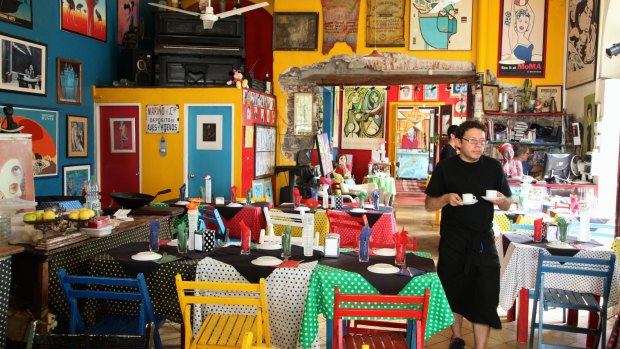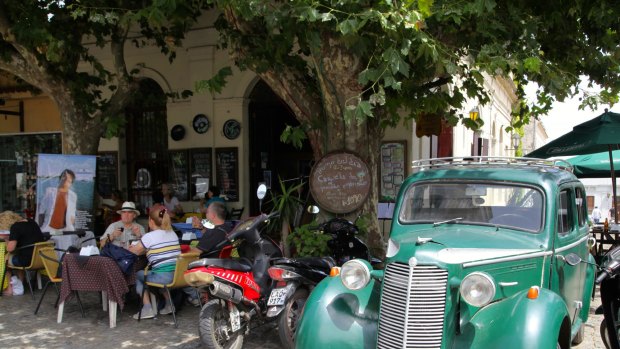By Kerry van der Jagt

Inside Colonia's quirky El Drugstore cafe.Credit: Kerry van der Jagt
It's not every day you can tread upon hallowed ground. Clutching a faded pink ticket - section 4, number 92 - I make my way inside Montevideo's Estadio Centenario. In my mind's eye I see the 93, 000 fans jammed inside the stadium for the final of the inaugural FIFA World Cup between Uruguay and Argentina. I can feel the sun beating down, smell the excitement and hear the roar of the crowd.
The year 1930 is stamped on my souvenir ticket; the year Uruguay hosted the first World Cup at the newly built Estadio Centenario. And not just hosted, but won, 4 - 2 against their archrival Argentina. The Centenario was so significant in the development of international football that FIFA has listed it as one of the world's classic football stadiums and declared it "an historical monument of world football".
Until touring the stadium and its small museum I'd never heard about the role Uruguay played in World Cup history. In fact I was ignorant of many things about this small country, hemmed between ego-driven Brazil and Argentina; I knew nothing about its elegant capital Montevideo or its fine beaches. I didn't know about candombe, Uruguay's African-derived music style or its liberal-minded government, which, in 2013, saw the legalisation of marijuana, abortion and same-sex marriage. I certainly didn't know the enchanting city of Colonia del Sacramento was an hour's ferry ride across the Rio de la Plata from the chaos of Buenos Aires.

Colonia's quirky El Drugstore cafe, where vintage cars have been parked outside and remodelled into seating booths.Credit: Kerry van der Jagt
Colonia's history is a turbulent one; founded by the Portuguese in 1680 (as a place to smuggle contraband into Buenos Aires) the fledgling city was soon taken over by the Spanish. For the next century these two heavy weights played tug of war, until 1777 when Spain emerged as victor, a situation that lasted until 1825 when the nation of Uruguay was formed as a buffer between Argentina and Brazil.
Today, this historic town of ruined forts, sherbet-coloured houses and sycamore-lined streets is a quiet haven. Trapped in a Cuban-like time warp, the streets are lined with vintage cars, mostly dilapidated yet dignified, like the town itself. Strolling the cobblestone alleys I see Studebakers, Ford Model Ts and ancient Citroens, even a purple VW beetle that could have come straight from The Love Bug. "Many television shows and movies supposedly shot in Cuba are filmed here," says local guide Nela Carbajal, who I've joined for a two-hour walking tour of Barrio Historico, the UNESCO-listed Old Town.
After visiting the city gate, lighthouse and main square Carbajal leads us to the town's most photogenic street, Calle de los Suspiros, or "Street of Sighs". And yes, its faded 18th-century beauty induces a collective sigh from our group. The original trough running down the middle of the cobbled lane still drains water to the nearby Rio de la Plata, while either side two rows of rose, rouge and russet stucco buildings serve as gourmet shops, studios and art galleries.
Carbajal leads us to the gallery of well-known Uruguayan artist Fernando Fraga, who now calls Colonia home. Fraga is away today but his father Alvaro invites us in to enjoy his son's artwork and also the hidden garden with its tangle of metal sculptures. "Artists and writers have always been drawn to Colonia," says Carbajal. "Not just for the beauty but for the town's creative and cultural vibe."
This vibe is found all across Colonia; on the walls of the local football stadium, which have been painted in colourful murals by local Colonia artists; at the quirky El Drugstore café, where three vintage cars have been parked outside and remodelled into seating booths; and in its collection of small museums clustered around Barrio Historico's main square. Carbajal suggests I visit the Tile Museum, a small stone cottage dedicated to Portuguese and Spanish tiles. Surrounded by shards of blue and white I begin to appreciate that the charm of Uruguay lays in the detail.
This realisation continues in the capital, Montevideo, an easy 2.5-hour bus ride from Colonia. Armed with a city map I tick off the big guns – Independence Plaza, Port Market, Teatro Solis, and Gate of the Citadel – but it's the small things that delight me the most. From the humble sausage stand, La Pasiva, which has been serving panchos (hot dogs) for 45 years (look for the queue near Plaza Fabini) to yerba mate, that grassy-tasting tea-like infusion the entire population is addicted to. While Argentinians also enjoy this hot beverage, only in Uruguay do locals clutch the flasks as if they are personal oxygen tanks. And if they're not sipping from the mate they are carrying it across their shoulders in stylish leather bags. "We like to make an occasion of it," says one young woman, in the understatement of the year.
The historic ciudad vieja (old city) is home to dozens of small museums from the
Museo Torres Garcia, displaying works by Cubist painter Joaquin Torres Garcia, to the Museo del Carnaval, which presents the tradition of Uruguayan carnivals. Amid displays of colourful costumes and masks I discover that while Uruguay's Carnival is not as famous as Brazil's, it is the longest lasting carnival in the world, running for 40 days from January to March each year. One feature of the festival is candombe, the music of Uruguay's African community, which descends from the slaves who arrived here in the 19th century.
At sunset I wander down to La Rambla, the 22-kilometre waterfront esplanade with its sweeping views across the Rio de la Plata to Buenos Aires, a mere three-hour ferry ride away. In the coming days I have more to learn; how chivitos, that monster-on-a-plate known as a steak sandwich, goes perfectly with chopp (draught beer); how the city glows like spun gold at sunset; and how a collection of artifacts from the first FIFA World Cup came to be sitting in the corner of a small museum in Montevideo.
TRIP NOTES
MORE INFORMATION
GETTING THERE
LAN Airlines operates seven one-stop flights each week from Sydney to Santiago, Chile, with onward connections to Buenos Aires, Argentina. Travellers from Melbourne can fly to Sydney or Auckland with codeshare partner airline and connect onward to South America with LAN Airlines. Phone 1800 126 038, see www.lan.com. Buquebus operates ferries from Buenos Aires to Colonia del Sacramento and Montevideo. See www.buquebus.com.
TOURING THERE
Adventure World specialises in curated soft-adventure trips to some of South America's most exotic and unique destinations. Phone 1300 363 055, see www.adventureworld.com.au.
The writer was a guest of LAN Airlines and Adventure World.
Sign up for the Traveller Deals newsletter
Get exclusive travel deals delivered straight to your inbox. Sign up now.